Digital Forensics: Ethical and Legal Challenges in Wearable Technology
VerifiedAdded on 2022/10/04
|6
|1335
|8
Report
AI Summary
This report delves into the application of digital forensics within the realm of wearable technologies, examining its advantages and disadvantages in the context of criminal investigations. The analysis encompasses a range of wearable devices, such as the Apple Watch and Fitbit, and explores the ethical and legal challenges that arise from the use of digital forensic techniques on these devices. The report highlights the benefits of digital forensics, including the ability to quickly identify and extract relevant data, and the challenges associated with data heterogeneity and security vulnerabilities. It also addresses the impact of cloud computing and the need for robust security measures to protect digital evidence. Furthermore, the report considers the impact of digital triage in the investigation process and the necessity for trained personnel. The report includes references to existing legal cases to illustrate the practical implications of these technologies and the importance of addressing the ethical and legal challenges associated with their use. This report underscores the evolving landscape of digital forensics and its significance in modern criminal investigations.
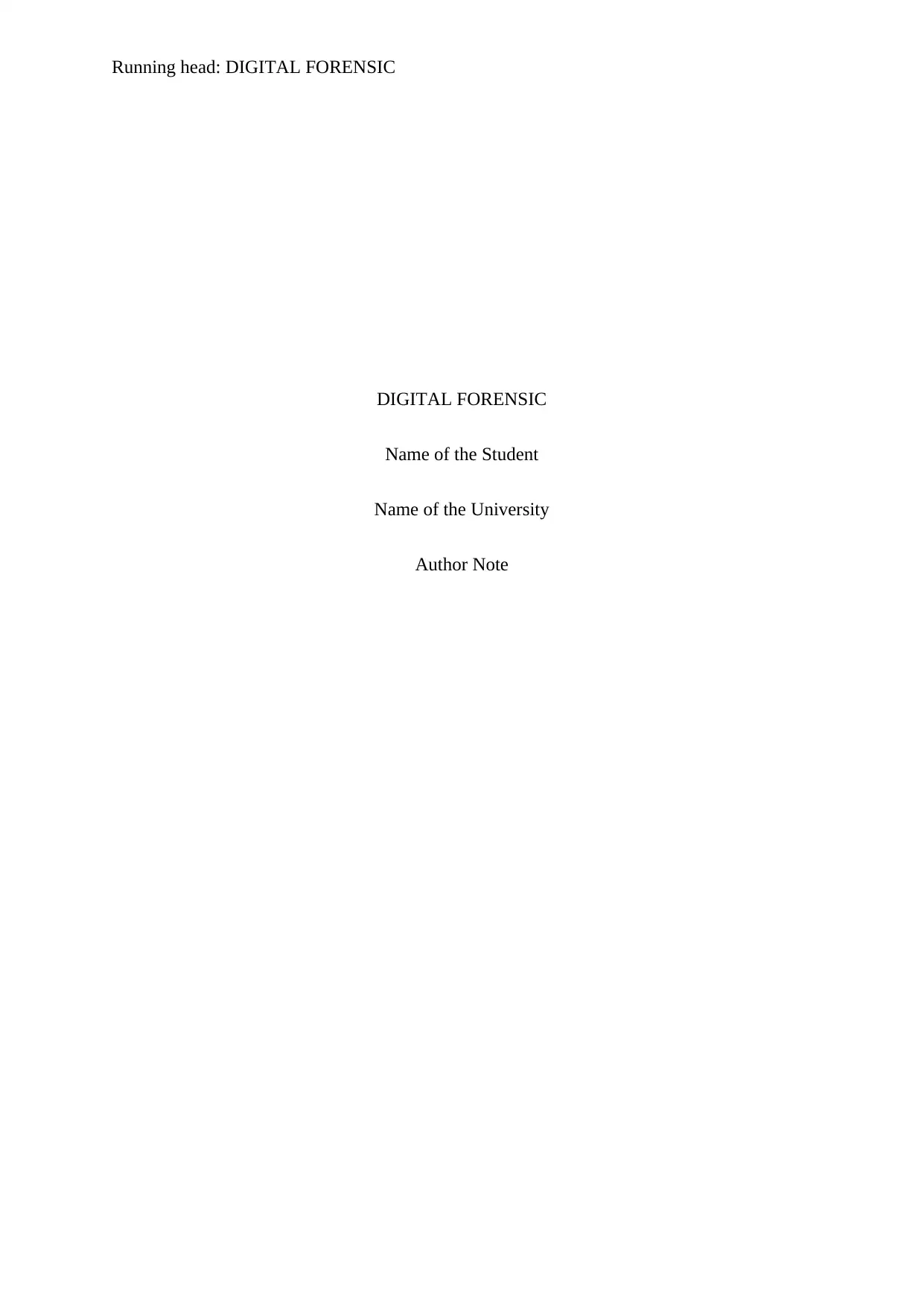
Running head: DIGITAL FORENSIC
DIGITAL FORENSIC
Name of the Student
Name of the University
Author Note
DIGITAL FORENSIC
Name of the Student
Name of the University
Author Note
Paraphrase This Document
Need a fresh take? Get an instant paraphrase of this document with our AI Paraphraser
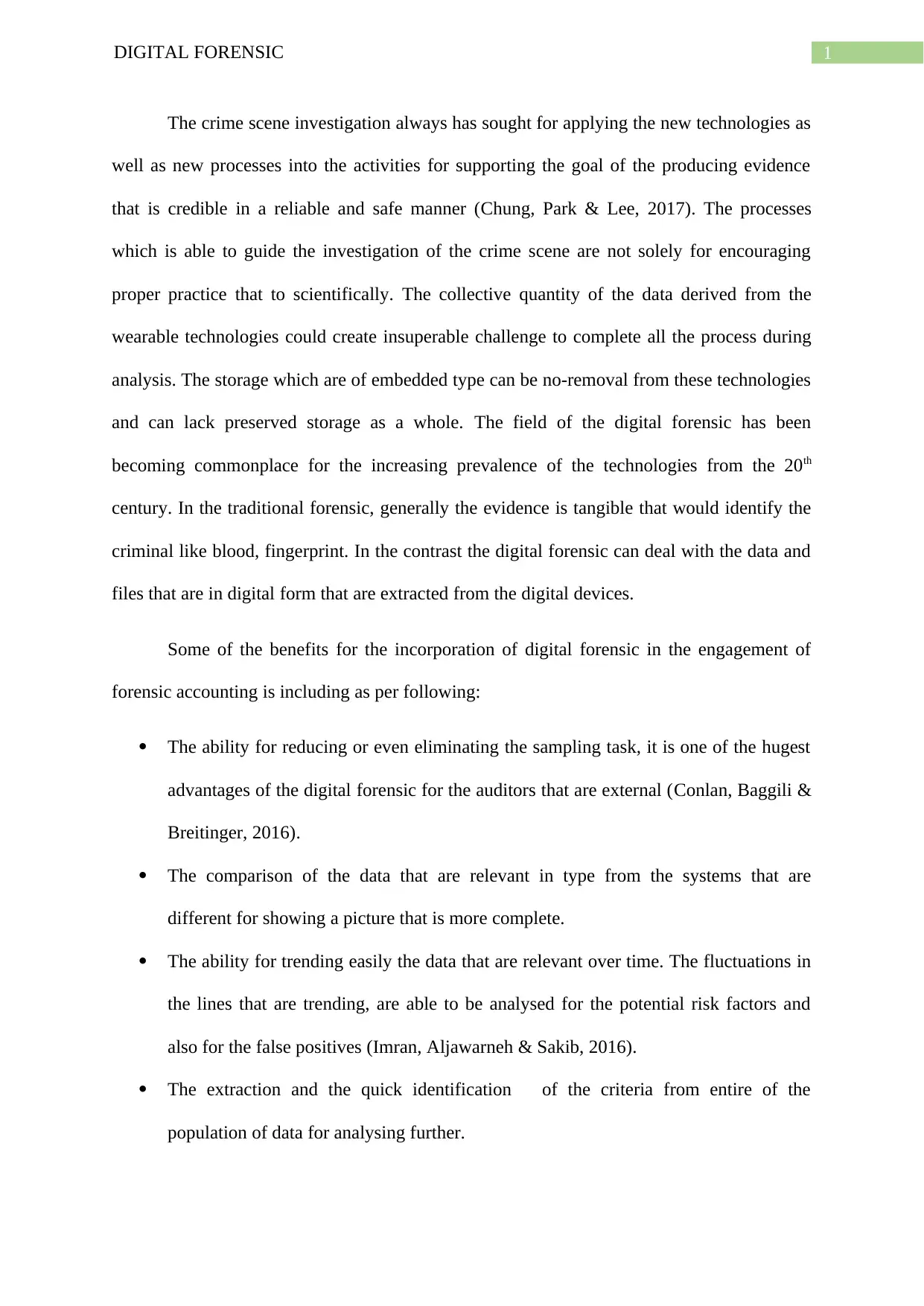
DIGITAL FORENSIC 1
The crime scene investigation always has sought for applying the new technologies as
well as new processes into the activities for supporting the goal of the producing evidence
that is credible in a reliable and safe manner (Chung, Park & Lee, 2017). The processes
which is able to guide the investigation of the crime scene are not solely for encouraging
proper practice that to scientifically. The collective quantity of the data derived from the
wearable technologies could create insuperable challenge to complete all the process during
analysis. The storage which are of embedded type can be no-removal from these technologies
and can lack preserved storage as a whole. The field of the digital forensic has been
becoming commonplace for the increasing prevalence of the technologies from the 20th
century. In the traditional forensic, generally the evidence is tangible that would identify the
criminal like blood, fingerprint. In the contrast the digital forensic can deal with the data and
files that are in digital form that are extracted from the digital devices.
Some of the benefits for the incorporation of digital forensic in the engagement of
forensic accounting is including as per following:
The ability for reducing or even eliminating the sampling task, it is one of the hugest
advantages of the digital forensic for the auditors that are external (Conlan, Baggili &
Breitinger, 2016).
The comparison of the data that are relevant in type from the systems that are
different for showing a picture that is more complete.
The ability for trending easily the data that are relevant over time. The fluctuations in
the lines that are trending, are able to be analysed for the potential risk factors and
also for the false positives (Imran, Aljawarneh & Sakib, 2016).
The extraction and the quick identification of the criteria from entire of the
population of data for analysing further.
The crime scene investigation always has sought for applying the new technologies as
well as new processes into the activities for supporting the goal of the producing evidence
that is credible in a reliable and safe manner (Chung, Park & Lee, 2017). The processes
which is able to guide the investigation of the crime scene are not solely for encouraging
proper practice that to scientifically. The collective quantity of the data derived from the
wearable technologies could create insuperable challenge to complete all the process during
analysis. The storage which are of embedded type can be no-removal from these technologies
and can lack preserved storage as a whole. The field of the digital forensic has been
becoming commonplace for the increasing prevalence of the technologies from the 20th
century. In the traditional forensic, generally the evidence is tangible that would identify the
criminal like blood, fingerprint. In the contrast the digital forensic can deal with the data and
files that are in digital form that are extracted from the digital devices.
Some of the benefits for the incorporation of digital forensic in the engagement of
forensic accounting is including as per following:
The ability for reducing or even eliminating the sampling task, it is one of the hugest
advantages of the digital forensic for the auditors that are external (Conlan, Baggili &
Breitinger, 2016).
The comparison of the data that are relevant in type from the systems that are
different for showing a picture that is more complete.
The ability for trending easily the data that are relevant over time. The fluctuations in
the lines that are trending, are able to be analysed for the potential risk factors and
also for the false positives (Imran, Aljawarneh & Sakib, 2016).
The extraction and the quick identification of the criteria from entire of the
population of data for analysing further.
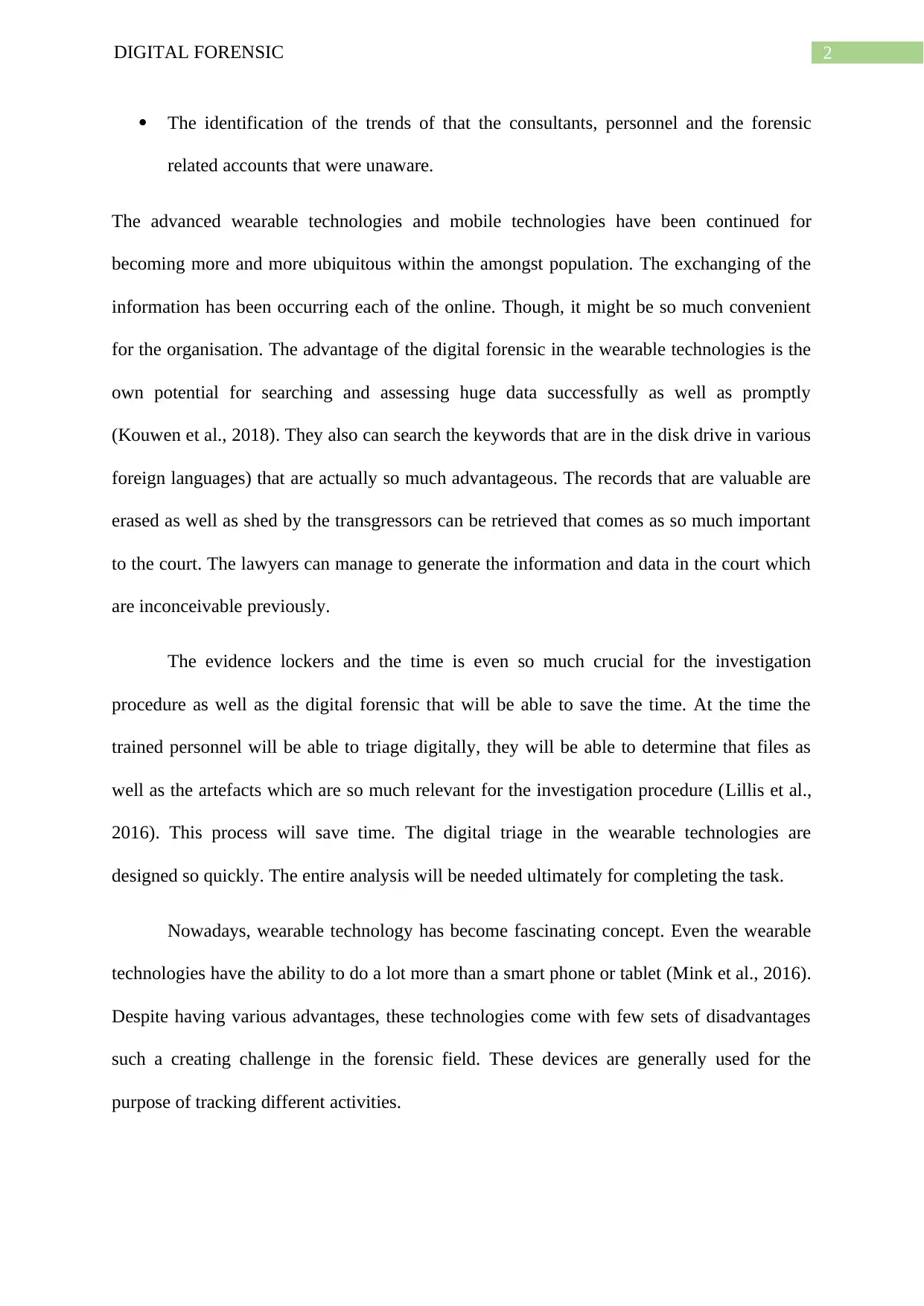
2DIGITAL FORENSIC
The identification of the trends of that the consultants, personnel and the forensic
related accounts that were unaware.
The advanced wearable technologies and mobile technologies have been continued for
becoming more and more ubiquitous within the amongst population. The exchanging of the
information has been occurring each of the online. Though, it might be so much convenient
for the organisation. The advantage of the digital forensic in the wearable technologies is the
own potential for searching and assessing huge data successfully as well as promptly
(Kouwen et al., 2018). They also can search the keywords that are in the disk drive in various
foreign languages) that are actually so much advantageous. The records that are valuable are
erased as well as shed by the transgressors can be retrieved that comes as so much important
to the court. The lawyers can manage to generate the information and data in the court which
are inconceivable previously.
The evidence lockers and the time is even so much crucial for the investigation
procedure as well as the digital forensic that will be able to save the time. At the time the
trained personnel will be able to triage digitally, they will be able to determine that files as
well as the artefacts which are so much relevant for the investigation procedure (Lillis et al.,
2016). This process will save time. The digital triage in the wearable technologies are
designed so quickly. The entire analysis will be needed ultimately for completing the task.
Nowadays, wearable technology has become fascinating concept. Even the wearable
technologies have the ability to do a lot more than a smart phone or tablet (Mink et al., 2016).
Despite having various advantages, these technologies come with few sets of disadvantages
such a creating challenge in the forensic field. These devices are generally used for the
purpose of tracking different activities.
The identification of the trends of that the consultants, personnel and the forensic
related accounts that were unaware.
The advanced wearable technologies and mobile technologies have been continued for
becoming more and more ubiquitous within the amongst population. The exchanging of the
information has been occurring each of the online. Though, it might be so much convenient
for the organisation. The advantage of the digital forensic in the wearable technologies is the
own potential for searching and assessing huge data successfully as well as promptly
(Kouwen et al., 2018). They also can search the keywords that are in the disk drive in various
foreign languages) that are actually so much advantageous. The records that are valuable are
erased as well as shed by the transgressors can be retrieved that comes as so much important
to the court. The lawyers can manage to generate the information and data in the court which
are inconceivable previously.
The evidence lockers and the time is even so much crucial for the investigation
procedure as well as the digital forensic that will be able to save the time. At the time the
trained personnel will be able to triage digitally, they will be able to determine that files as
well as the artefacts which are so much relevant for the investigation procedure (Lillis et al.,
2016). This process will save time. The digital triage in the wearable technologies are
designed so quickly. The entire analysis will be needed ultimately for completing the task.
Nowadays, wearable technology has become fascinating concept. Even the wearable
technologies have the ability to do a lot more than a smart phone or tablet (Mink et al., 2016).
Despite having various advantages, these technologies come with few sets of disadvantages
such a creating challenge in the forensic field. These devices are generally used for the
purpose of tracking different activities.
⊘ This is a preview!⊘
Do you want full access?
Subscribe today to unlock all pages.

Trusted by 1+ million students worldwide
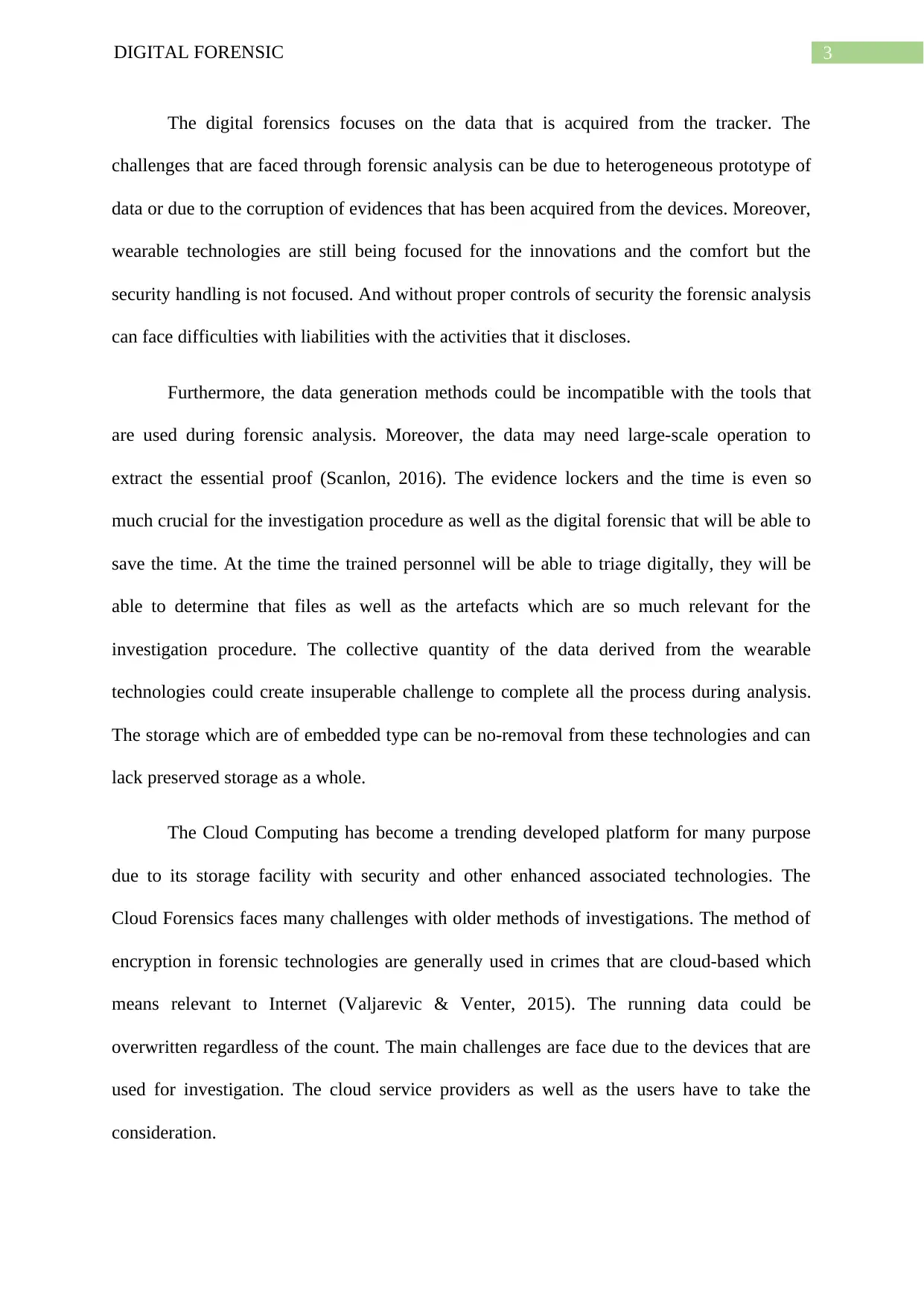
3DIGITAL FORENSIC
The digital forensics focuses on the data that is acquired from the tracker. The
challenges that are faced through forensic analysis can be due to heterogeneous prototype of
data or due to the corruption of evidences that has been acquired from the devices. Moreover,
wearable technologies are still being focused for the innovations and the comfort but the
security handling is not focused. And without proper controls of security the forensic analysis
can face difficulties with liabilities with the activities that it discloses.
Furthermore, the data generation methods could be incompatible with the tools that
are used during forensic analysis. Moreover, the data may need large-scale operation to
extract the essential proof (Scanlon, 2016). The evidence lockers and the time is even so
much crucial for the investigation procedure as well as the digital forensic that will be able to
save the time. At the time the trained personnel will be able to triage digitally, they will be
able to determine that files as well as the artefacts which are so much relevant for the
investigation procedure. The collective quantity of the data derived from the wearable
technologies could create insuperable challenge to complete all the process during analysis.
The storage which are of embedded type can be no-removal from these technologies and can
lack preserved storage as a whole.
The Cloud Computing has become a trending developed platform for many purpose
due to its storage facility with security and other enhanced associated technologies. The
Cloud Forensics faces many challenges with older methods of investigations. The method of
encryption in forensic technologies are generally used in crimes that are cloud-based which
means relevant to Internet (Valjarevic & Venter, 2015). The running data could be
overwritten regardless of the count. The main challenges are face due to the devices that are
used for investigation. The cloud service providers as well as the users have to take the
consideration.
The digital forensics focuses on the data that is acquired from the tracker. The
challenges that are faced through forensic analysis can be due to heterogeneous prototype of
data or due to the corruption of evidences that has been acquired from the devices. Moreover,
wearable technologies are still being focused for the innovations and the comfort but the
security handling is not focused. And without proper controls of security the forensic analysis
can face difficulties with liabilities with the activities that it discloses.
Furthermore, the data generation methods could be incompatible with the tools that
are used during forensic analysis. Moreover, the data may need large-scale operation to
extract the essential proof (Scanlon, 2016). The evidence lockers and the time is even so
much crucial for the investigation procedure as well as the digital forensic that will be able to
save the time. At the time the trained personnel will be able to triage digitally, they will be
able to determine that files as well as the artefacts which are so much relevant for the
investigation procedure. The collective quantity of the data derived from the wearable
technologies could create insuperable challenge to complete all the process during analysis.
The storage which are of embedded type can be no-removal from these technologies and can
lack preserved storage as a whole.
The Cloud Computing has become a trending developed platform for many purpose
due to its storage facility with security and other enhanced associated technologies. The
Cloud Forensics faces many challenges with older methods of investigations. The method of
encryption in forensic technologies are generally used in crimes that are cloud-based which
means relevant to Internet (Valjarevic & Venter, 2015). The running data could be
overwritten regardless of the count. The main challenges are face due to the devices that are
used for investigation. The cloud service providers as well as the users have to take the
consideration.
Paraphrase This Document
Need a fresh take? Get an instant paraphrase of this document with our AI Paraphraser

4DIGITAL FORENSIC
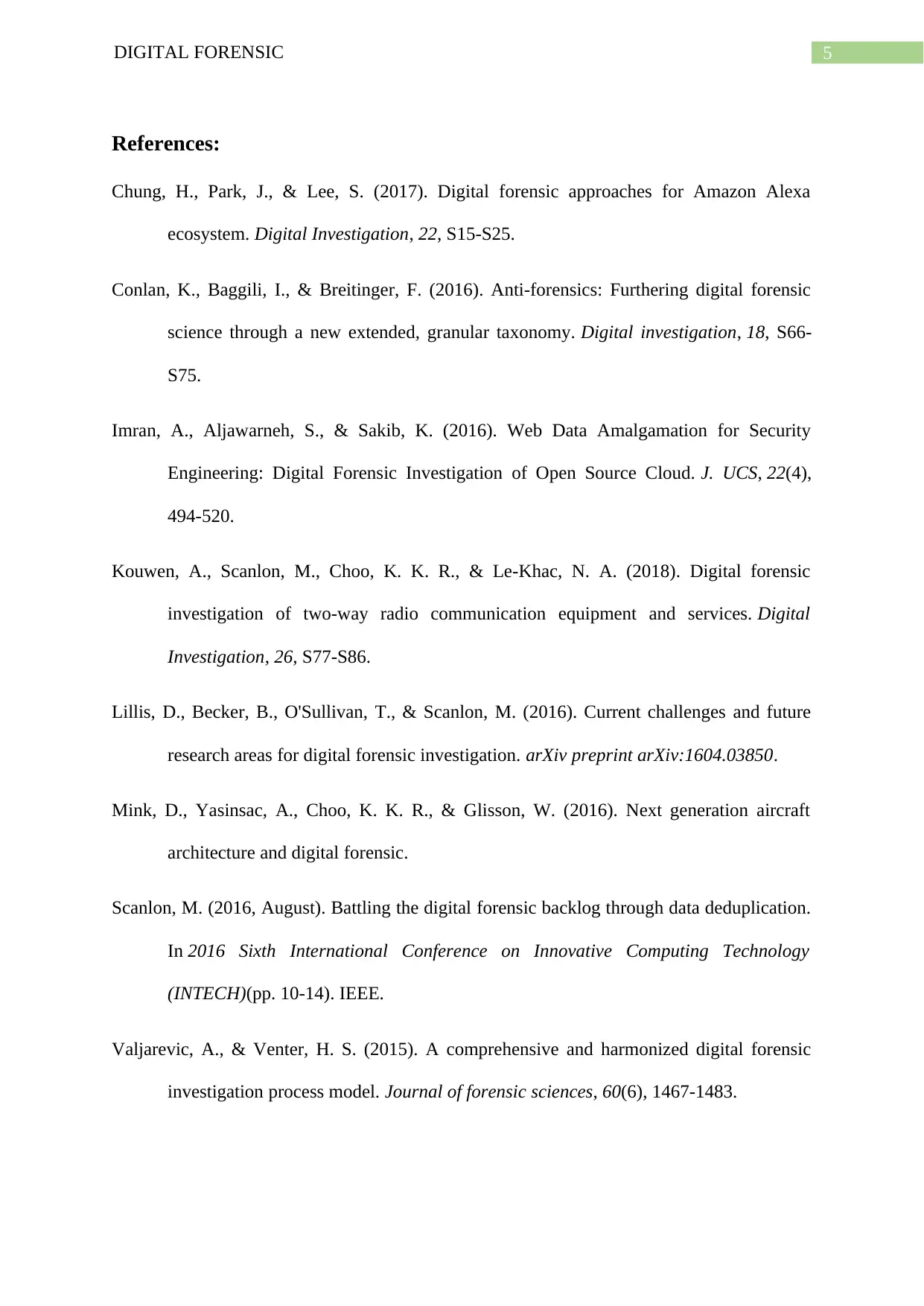
5DIGITAL FORENSIC
References:
Chung, H., Park, J., & Lee, S. (2017). Digital forensic approaches for Amazon Alexa
ecosystem. Digital Investigation, 22, S15-S25.
Conlan, K., Baggili, I., & Breitinger, F. (2016). Anti-forensics: Furthering digital forensic
science through a new extended, granular taxonomy. Digital investigation, 18, S66-
S75.
Imran, A., Aljawarneh, S., & Sakib, K. (2016). Web Data Amalgamation for Security
Engineering: Digital Forensic Investigation of Open Source Cloud. J. UCS, 22(4),
494-520.
Kouwen, A., Scanlon, M., Choo, K. K. R., & Le-Khac, N. A. (2018). Digital forensic
investigation of two-way radio communication equipment and services. Digital
Investigation, 26, S77-S86.
Lillis, D., Becker, B., O'Sullivan, T., & Scanlon, M. (2016). Current challenges and future
research areas for digital forensic investigation. arXiv preprint arXiv:1604.03850.
Mink, D., Yasinsac, A., Choo, K. K. R., & Glisson, W. (2016). Next generation aircraft
architecture and digital forensic.
Scanlon, M. (2016, August). Battling the digital forensic backlog through data deduplication.
In 2016 Sixth International Conference on Innovative Computing Technology
(INTECH)(pp. 10-14). IEEE.
Valjarevic, A., & Venter, H. S. (2015). A comprehensive and harmonized digital forensic
investigation process model. Journal of forensic sciences, 60(6), 1467-1483.
References:
Chung, H., Park, J., & Lee, S. (2017). Digital forensic approaches for Amazon Alexa
ecosystem. Digital Investigation, 22, S15-S25.
Conlan, K., Baggili, I., & Breitinger, F. (2016). Anti-forensics: Furthering digital forensic
science through a new extended, granular taxonomy. Digital investigation, 18, S66-
S75.
Imran, A., Aljawarneh, S., & Sakib, K. (2016). Web Data Amalgamation for Security
Engineering: Digital Forensic Investigation of Open Source Cloud. J. UCS, 22(4),
494-520.
Kouwen, A., Scanlon, M., Choo, K. K. R., & Le-Khac, N. A. (2018). Digital forensic
investigation of two-way radio communication equipment and services. Digital
Investigation, 26, S77-S86.
Lillis, D., Becker, B., O'Sullivan, T., & Scanlon, M. (2016). Current challenges and future
research areas for digital forensic investigation. arXiv preprint arXiv:1604.03850.
Mink, D., Yasinsac, A., Choo, K. K. R., & Glisson, W. (2016). Next generation aircraft
architecture and digital forensic.
Scanlon, M. (2016, August). Battling the digital forensic backlog through data deduplication.
In 2016 Sixth International Conference on Innovative Computing Technology
(INTECH)(pp. 10-14). IEEE.
Valjarevic, A., & Venter, H. S. (2015). A comprehensive and harmonized digital forensic
investigation process model. Journal of forensic sciences, 60(6), 1467-1483.
⊘ This is a preview!⊘
Do you want full access?
Subscribe today to unlock all pages.

Trusted by 1+ million students worldwide
1 out of 6
Related Documents
Your All-in-One AI-Powered Toolkit for Academic Success.
+13062052269
info@desklib.com
Available 24*7 on WhatsApp / Email
![[object Object]](/_next/static/media/star-bottom.7253800d.svg)
Unlock your academic potential
Copyright © 2020–2025 A2Z Services. All Rights Reserved. Developed and managed by ZUCOL.




